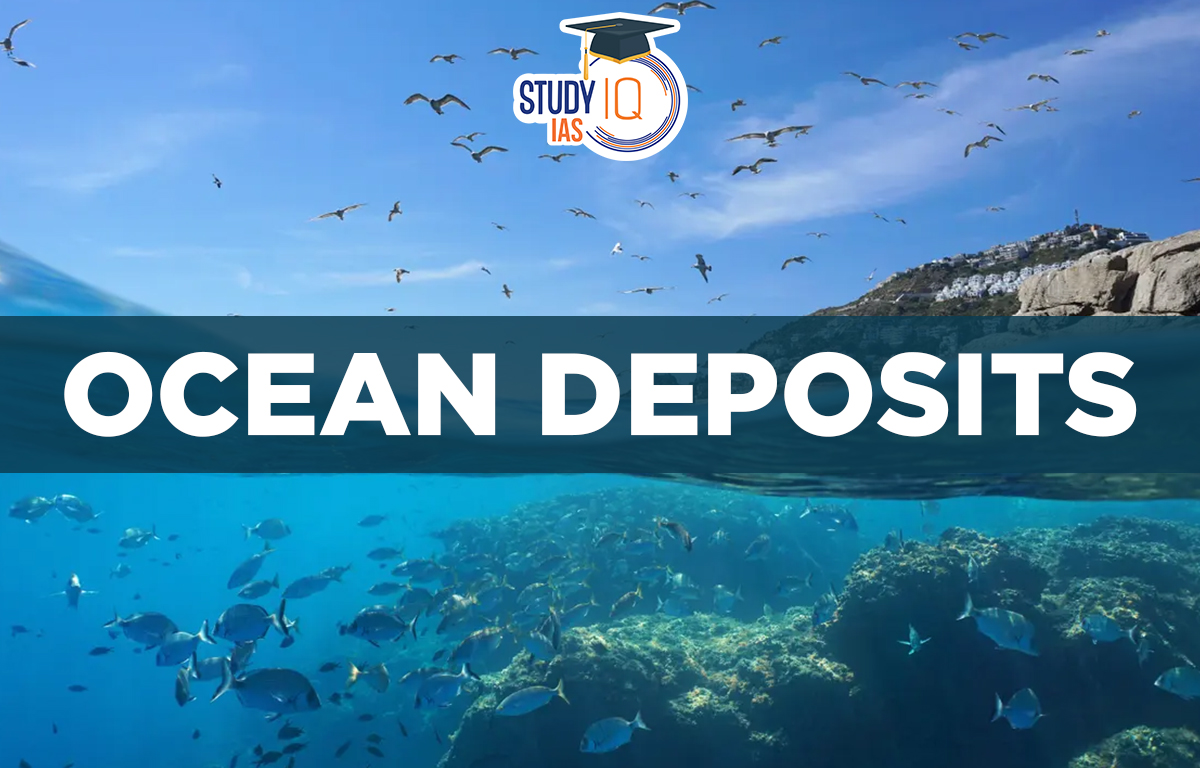Table of Contents
Ocean Deposits
An ocean deposit is a natural buildup of solid, liquid, or gas found on the Earth’s surface, in its waters, or in the atmosphere. These deposits are also called marine deposits, and the process of forming them is known as marine deposition. In this article, we will define Ocean Deposits, discuss the various types, and provide some examples. We will also clear up any confusion about this topic to help you understand it better.
Read about: Indian Ocean
Ocean Deposit Definition
Ocean deposits are materials that settle at the bottom of the oceans. They include tiny plants and animals, as well as large rocks and minerals. This accumulation happens naturally over time, with materials coming from both land and ocean. These deposits form layers of sediment on the ocean floor, each layer telling a story about the Earth’s history and past climates.
Read about: Pacific Ocean
Ocean Deposits Types
Ocean Deposits can be classified using various criteria such as location, depth, sediments, and so on that are described below:
Shelf Deposits
These are deposits found on the continental shelf, which is the most shallow part of the ocean. Shelf deposits are further subdivided into four types:
| Type | Details |
| Terrigenous Deposits | These are deposits formed by materials transported to the ocean by rivers, winds, or glaciers. |
| Biogenous Deposits | Biogenious Deposits are deposits formed by the remains of marine organisms. |
| Hydrogenous Deposits | These are deposits formed when minerals precipitate out of a water solution. |
| Cosmogenic Deposits | These are deposits formed on the ocean floor by the action of cosmic rays. |
Read about: Indian Ocean Dipole
Ocean Deposits Based on Depth
| Types | Details |
| Continental Shelf Deposits | These are deposits found on the continental shelf, which is the shallowest part of the ocean. |
| Continental Slope Deposits | These are deposits found on the ocean’s steepest part, the continental slope. |
| Oceanic Basin Deposits | These are deposits found in the ocean’s deepest part, the oceanic basin. |
Read More: Ocean Currents
Ocean Deposits Based on Sediments
Clastic Deposits
These are deposits made up of rock or sediment particles that have been transported to the ocean by rivers, wind, or glaciers.
Non-clastic Deposits
These are deposits that are made up of minerals that have precipitated out of solution in water rather than rock or sediment particles. Ocean deposits can also be classified according to whether they are natural or man-made.
Ocean Deposits Significance
Ocean deposits are significant because:
- Give information about the ocean’s history.
- It can be used to investigate changes in ocean currents.
- Can be used to investigate the ocean floor
- Provide historical climate data.
- Can be used to investigate the role of the ocean in the carbon cycle.
- Can be used to investigate the role of the ocean in the global water cycle.
Ocean deposits are important for many reasons. They give us information about the ocean and how it has changed over time. They also help in the study of oceanography, which is the science of the ocean.
Oceanography is the study of the physical and chemical properties of the ocean, as well as its interactions with the Atmosphere, lithosphere, and Hydrosphere. It discusses everything from plate tectonics and ocean currents to marine life and oceanography.
Ocean deposits are important for studying climate change, which is a big issue for our planet. The ocean plays a key role in controlling the Earth’s climate. By looking at ocean deposits, scientists can learn how the ocean reacted to past climate changes and how it might react to future ones.
Read More: Ocean Waves
Ocean Deposits Examples
Examples of ocean deposits are classified based on their mineralogy, chemistry, and texture. The following are some examples of ocean deposits:
- Basalt, gabbro, and granite are examples of rocks found in the oceanic crust.
- Minerals found in ocean deposits include olivine, pyroxene, and amphibole.
- Clay, sand, and gravel are examples of ocean sediments.
- Ocean organisms such as plankton, algae, and corals are also examples of ocean deposits.
Read More: Ocean Tides
Ocean Deposits UPSC
It is critical to understand the concept of ocean deposit in order to make informed decisions about how we use the world’s oceans. Ocean deposits are an important part of Earth’s geology and affect many aspects of our lives, from the food we eat to the water we drink. We can make better decisions about how to use and conserve our environment if we have a better understanding of ocean deposits. Ocean deposit types can be classified based on how they are formed. This article discusses the definition of ocean deposit, ocean deposit types, and ocean deposit examples.


 Story of Meera Bai and Her Devotion For ...
Story of Meera Bai and Her Devotion For ...
 Desert Climate, Distribution, Climatic C...
Desert Climate, Distribution, Climatic C...
 Deserts of India Map, Features of Thar D...
Deserts of India Map, Features of Thar D...





















